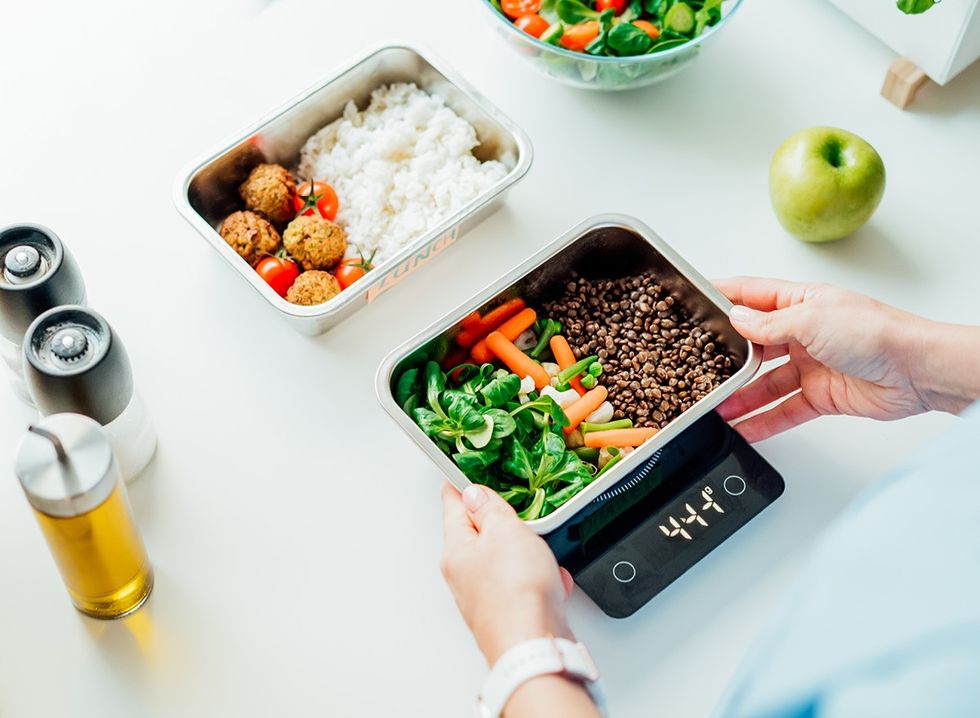Are you trying to lose weight by eating “healthy” foods but can’t seem to achieve success? There’s a good chance you are eating the wrong stuff. Brittney Blanco is a Macros Nutrition Coach and social media influencer who regularly shares her creative weight loss meal recipes with her followers. In a new post, she reveals 8 foods with hidden calories that you might be mistaken for healthy foods. “Reminder: No food is ‘bad,’ but some can quickly add up in calories, making it harder to stay in a deficit. Measure portions and stay mindful to enjoy these foods while staying on track with your goals!” she writes. “Here are 8 foods with hidden calories that make it tough to lose weight.”
Coconut Oil

Are you cooking or baking with coconut oil? Often labeled as a “healthy fat,” coconut oil contains about 120 calories per tablespoon, says Brittney. “If you’re using it to cook or bake, the calories can quickly add up, especially if you don’t measure.”
Trail Mix

Growing up, you may have thought that trail mix is a super healthy snack. However, oftentimes it isn’t. “This popular snack can pack 300-500 calories per cup, depending on the mix. The combination of nuts, dried fruit, and chocolate pieces is calorie-dense and easy to overeat. Opt for smaller portions,” she says.
Cheese

It can be tempting to grab a chunk or slice of cheese if you are hungry, but you may want to think twice, according to Brittney. “One slice of cheddar cheese contains about 110 calories. A sprinkle here and a slice there can add up, especially if you’re not measuring. Grated cheese is particularly tricky to estimate accurately,” she says.
Smoothie Bowls

Acai and other smoothie bowls are delicious and boast lots of antioxidants, but they might not help you lose weight. “These Instagram-worthy bowls can range from 300 to 600+ calories, thanks to toppings like granola, nut butter, and honey. While full of nutrients, they’re often calorie-dense and best enjoyed in moderation,” says Brittney.
RELATED: The 4 Breakfast Changes That Made Me Lose 12 Pounds in 3 Weeks
Sauces and Condiments

Sauces and condiments may seem harmless, but they can actually boast more calories than your protein. According to Brittney, barbecue sauce contains about 70 calories per 2 tablespoons, while teriyaki sauce has 60 calories per tablespoon. “These flavorful additions can turn a low-calorie dish into a calorie bomb,” she says.
Fancy Coffee Drinks

Ordering up your favorite Starbucks drink can derail your diet in an instant. “Specialty coffee drinks with whipped cream, syrups, and milk can easily exceed 300 calories. Even ‘lighter’ options like oat milk lattes can add up when consumed daily,” she writes.
Cereal

Many of us grew up eating cereal for breakfast, but most actually offer very little nutritional benefits. “A serving of cereal might be labeled as 120-150 calories, but most people pour two or three times the recommended portion. Add milk, and your breakfast could top 300 calories before you know it,” she says.
RELATED: I Flattened My Belly by Eating Foods with This 1:1 Ratio
Muffins

Another not-so-healthy item we grew up thinking was healthy—most muffins. “Store-bought muffins often contain 400-600 calories, even for ‘healthier’ options like bran or blueberry. They’re calorie-dense and often loaded with sugar, making them more like dessert than breakfast,” says Brittney.
What to Eat for Breakfast If You Want to Be Fit

In another post she reveals a sample menu of what to eat 80 percent of the time if you want to be fit, starting with breakfast.
- 3-4 eggs - High in protein and healthy fats for sustained energy,
- 1 cup Oikos Greek yogurt - Adds additional protein and probiotics,
- 1 cup berries - Low-calorie, high-fiber carb source packed with antioxidants.
Macros: Calories: ~350 kcal, Protein: ~33-39g, Carbs: ~15g, Fat: ~15-20g.
What to Eat for Lunch If You Want to Be Fit

- Grilled chicken breast (50g protein) - Lean protein source to support muscle and satiety,
- 1 fist-size sweet potato - Complex carb for steady energy,
- Mixed veggies - Fiber, vitamins, and minerals to round out your meal.
Macros: Calories: ~400 kcal, Protein: ~50g, Carbs: ~30g, Fat: ~5-10g.
RELATED: 8 Tips to Make Losing Weight Feel Effortless, From Proven Experts
What to Eat for Dinner If You Want to Be Fit

- Lean steak or ground beef (50g protein) - Hearty protein source rich in iron,
- 1 cup jasmine rice -Easy-to-digest carbs to replenish glycogen stores,
- Mixed veggies - Nutrient-dense to support overall health.
Macros: Calories: ~500 kcal, Protein: ~50g, Carbs: ~40g, Fat: ~10-15g.
What to Eat for a Late Night Snack If You Want to Be Fit

- Egg wrap,
- 1 tbsp powdered peanut butter (mixed with water for a creamy texture),
- 1 tbsp Nuts ’n More - Both peanut butter and Nuts ’n More provide protein and healthy fats to keep you satisfied overnight.
Macros: Calories: ~200 kcal, Protein: ~15g, Carbs: ~10g, Fat: ~10g.
And if you enjoyed this article, take advantage of these 15 Quick Ways to Lose Body Fat Percentage in a Week.








 27. Regular YogurtShutterstock
27. Regular YogurtShutterstock Shutterstock
Shutterstock Shutterstock
Shutterstock A Day of Measured EatingShutterstock
A Day of Measured EatingShutterstock











 I'm a Nutritionist and These 9 High-Protein Snacks Keep My Clients Full While Losing 50 Pounds
I'm a Nutritionist and These 9 High-Protein Snacks Keep My Clients Full While Losing 50 Pounds
 Shutterstock
Shutterstock 2. Processed FoodsShutterstock
2. Processed FoodsShutterstock Shutterstock
Shutterstock Shutterstock/Prostock-studio
Shutterstock/Prostock-studio Shutterstock
Shutterstock Pro TipsShutterstock
Pro TipsShutterstock Shutterstock
Shutterstock Shutterstock
Shutterstock Shutterstock
Shutterstock Shutterstock
Shutterstock Don’t Drink as Much AlcoholShutterstock
Don’t Drink as Much AlcoholShutterstock Most Women on GLP-1s Are Making a Few Common MistakesShutterstock
Most Women on GLP-1s Are Making a Few Common MistakesShutterstock Soda and Sugary DrinksShutterstock
Soda and Sugary DrinksShutterstock Shutterstock
Shutterstock Eat BreakfastShutterstock
Eat BreakfastShutterstock And Improve Insulin SensitivityShutterstock
And Improve Insulin SensitivityShutterstock Belly Flab Strip Tip: Sugar and Fat Calories Leave Its Mark on Your BodyShutterstock
Belly Flab Strip Tip: Sugar and Fat Calories Leave Its Mark on Your BodyShutterstock Shutterstock
Shutterstock The Drugs Mimic the GLP-1 Hormone Naturally Produced by the BodyShutterstock
The Drugs Mimic the GLP-1 Hormone Naturally Produced by the BodyShutterstock 3. Deep-Fried ItemsShutterstock
3. Deep-Fried ItemsShutterstock